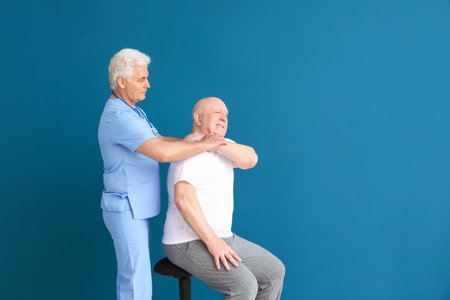1. Introduction to Parkinson’s Disease and Physical Therapy
Parkinson’s disease (PD) is a progressive neurological disorder that affects movement and coordination. In the United States, nearly one million people are living with PD, and this number is expected to rise in the coming years. The symptoms of Parkinson’s can range from mild tremors to significant difficulties with walking, balance, and everyday activities. These challenges often impact not only the individuals diagnosed but also their families and caregivers.
Overview of Parkinson’s Disease
PD primarily affects the brain’s ability to produce dopamine, a chemical that helps control movement. As dopamine levels decrease, people with PD may notice symptoms such as:
- Tremors or shaking
- Muscle stiffness
- Slowed movements (bradykinesia)
- Balance problems
- Difficulty with daily tasks like getting dressed or walking
Impact on Daily Life in the U.S.
The impact of Parkinson’s disease goes beyond physical symptoms. Many Americans living with PD face emotional and social challenges, including feelings of isolation and changes in their ability to participate in work or community activities. Managing daily routines can become overwhelming without proper support.
| Aspect of Daily Life | Common Challenges with PD | How Physical Therapy Helps |
|---|---|---|
| Mobility | Walking difficulties, risk of falls | Improves balance and strength, reduces fall risk |
| Self-care | Trouble dressing, bathing, eating | Teaches adaptive techniques for independence |
| Mental Health | Anxiety, depression from decreased activity | Encourages movement, boosts confidence and mood |
| Community Participation | Lack of social engagement due to mobility limits | Supports return to hobbies and social life |
The Significance of Physical Therapy in Comprehensive Care
Physical therapy is a key part of managing Parkinson’s disease. It’s more than just exercise—it includes specialized strategies designed by licensed therapists who understand the unique needs of people with PD. Physical therapy can help slow down the progression of motor symptoms, improve mobility, reduce pain, and promote safety at home and in the community. By working closely with other healthcare providers, physical therapists ensure that care is personalized for each individual’s goals and lifestyle.
2. Evidence Supporting Physical Therapy Interventions
Physical therapy (PT) is now widely recognized as a key part of managing Parkinson’s Disease (PD). Many studies in the United States and around the world have shown that PT can help people with PD move better, stay independent longer, and enjoy a higher quality of life. Let’s look at what research says about how different physical therapy approaches work for people living with PD.
How Physical Therapy Helps People with Parkinson’s Disease
Research shows that physical therapy can address some of the most common symptoms of PD, including:
- Difficulty walking
- Balance problems
- Muscle stiffness
- Trouble with everyday activities
- Risk of falling
By focusing on movement, strength, balance, and flexibility, PT helps people with PD manage these symptoms more effectively.
Main Types of Physical Therapy Approaches Backed by Research
| PT Approach | Main Benefits | Supporting Research Findings |
|---|---|---|
| Gait Training (Walking Practice) | Improves walking speed and stability; reduces shuffling steps | Studies show significant improvements in walking ability and confidence in daily activities |
| Balance Exercises | Lowers risk of falls; improves posture and steadiness when standing or moving | Clinical trials report fewer falls and better balance after regular sessions |
| Strength Training | Makes muscles stronger; helps with getting up from chairs or climbing stairs | Research supports increased muscle power and improved performance in daily tasks |
| Flexibility Exercises (Stretching) | Reduces muscle stiffness; increases range of motion in joints | Participants report less rigidity and greater ease of movement after stretching programs |
| Cueing Strategies (like using music or counting out loud) | Helps overcome “freezing” episodes; improves timing of movements | Studies find cueing can shorten freezing episodes and make walking smoother |
| Task-Specific Training (practicing real-life activities) | Makes daily routines easier; boosts confidence in self-care skills | Results show better independence with dressing, bathing, and other tasks at home |
The Big Picture: Improved Quality of Life
A review of current research highlights that people who participate in regular physical therapy not only move better but also feel better emotionally. They often report less fear of falling, more social engagement, and overall higher satisfaction with their daily lives.
The Bottom Line from U.S.-Based Guidelines and Studies
The American Physical Therapy Association (APTA) recommends personalized PT programs for everyone diagnosed with Parkinson’s Disease. Evidence shows that starting therapy early—before symptoms get worse—leads to the best results. Working closely with a licensed physical therapist ensures exercises are safe, enjoyable, and tailored to each person’s needs and goals.

3. Key Physical Therapy Strategies for Parkinson’s Disease
Evidence-Based Techniques Tailored for the American Setting
Physical therapy plays a vital role in helping people with Parkinson’s disease maintain independence and improve quality of life. In the United States, therapists use a combination of proven techniques that can be personalized to each individual’s needs and lifestyle. Below are some of the most effective strategies used in American clinics and community settings:
Gait Training
Walking difficulties are common in Parkinson’s disease. Physical therapists often use gait training exercises to help patients walk more safely and confidently. This may include practicing large steps, using rhythmic cues like music or metronomes, and working on turning safely. Therapists might also introduce assistive devices such as canes or walkers when needed.
Balance Exercises
Improving balance is key to reducing falls, which are a major concern for people with Parkinson’s. Therapists design balance programs that are fun and practical, often incorporating activities like standing on different surfaces, stepping over obstacles, or even participating in group exercise classes at local community centers.
Strength Building
Building muscle strength helps support movement and daily activities. Strengthening programs often focus on the legs, core, and arms using resistance bands, light weights, or even body weight exercises. These routines can be done at home or at the gym, making them accessible for people across the U.S.
Task-Specific Functional Training
This approach involves practicing real-life movements that are important for daily living. For example, therapists may help someone practice getting up from a chair, reaching for items in the kitchen, or safely crossing busy streets—skills that make a big difference in everyday American life.
Overview of Key Strategies
| Strategy | Description | Common Tools/Settings in the U.S. |
|---|---|---|
| Gait Training | Improves walking patterns and safety | Treadmills, metronomes, community walking tracks |
| Balance Exercises | Reduces risk of falls through targeted activities | Foam pads, balance boards, group fitness classes |
| Strength Building | Increases muscle power for daily tasks | Resistance bands, free weights, home gyms |
| Task-Specific Training | Makes everyday movements easier and safer | Kitchens, living rooms, outdoor environments |
These evidence-based physical therapy techniques are widely adopted across the United States. By tailoring interventions to each person’s goals and home environment, therapists help individuals with Parkinson’s stay active and independent for as long as possible.
4. Interdisciplinary Collaboration and Patient-Centered Care
Managing Parkinson’s Disease (PD) in the United States goes beyond just one specialist or treatment approach. Physical therapists play a key role, but the best results come from close teamwork between different healthcare professionals and caregivers. This approach helps people with PD get care that fits their unique needs and daily lives.
Why Teamwork Matters
Because PD affects movement, thinking, and daily activities, it takes more than just physical therapy to manage all the symptoms. When physical therapists work closely with neurologists, occupational therapists, speech therapists, and caregivers, each professional brings a different perspective and skill set. Together, they create a plan that looks at the whole person—not just their diagnosis.
Key Roles in the Care Team
| Team Member | Main Responsibilities |
|---|---|
| Physical Therapist | Improves strength, balance, and mobility; teaches exercises to manage symptoms |
| Neurologist | Diagnoses and manages medications; monitors disease progression |
| Occupational Therapist | Helps with daily living skills; suggests adaptive equipment for home safety |
| Speech Therapist | Treats speech and swallowing difficulties; improves communication skills |
| Caregivers/Family Members | Supports daily routines; helps with medication and exercise follow-through |
Patient-Centered Care in Action
A patient-centered approach means listening to what matters most to each person living with PD. For example, some people want to stay active in their community or keep doing hobbies they love. By sharing goals in team meetings, everyone works together to support those priorities—whether that’s walking safely, preparing meals independently, or socializing with friends.
The American Approach to Holistic Support
In the U.S., healthcare providers often use care coordination tools like electronic health records and regular team check-ins. These help make sure everyone on the care team is updated about changes in treatment plans or symptoms. Insurance companies may also require coordinated care plans before approving certain therapies or services.
The Benefits of Working as a Team:
- Better Communication: Everyone knows what treatments are happening and can adjust as needed.
- Faster Problem-Solving: Issues like falls or medication side effects are addressed quickly.
- Smoother Transitions: Moving from hospital to home is easier when all providers are on the same page.
- Moral Support: Families feel less alone when professionals guide them step by step.
This collaborative, patient-focused model is becoming standard practice across many U.S. clinics and hospitals. It helps individuals with Parkinson’s Disease live safer, fuller lives while making sure every aspect of their health is considered.
5. Barriers, Access, and Culturally Relevant Considerations
While physical therapy (PT) offers significant benefits for people with Parkinson’s disease (PD), many Americans face challenges in accessing these services. Understanding these barriers can help healthcare providers, families, and patients find practical solutions.
Insurance Coverage and Financial Barriers
In the United States, insurance plays a big role in whether someone can get regular PT. Medicare, Medicaid, and private insurance plans often cover some PT sessions, but there are limits on the number of visits or types of therapy covered. Out-of-pocket costs like copays or deductibles can add up quickly. For those without insurance or with high-deductible plans, affording consistent PT becomes even harder.
| Barrier | Description | Potential Solutions |
|---|---|---|
| Insurance Limitations | Capped number of sessions per year; prior authorization required; not all clinics accept every plan | Check plan details before starting; ask about exceptions for chronic conditions; look into community resources |
| Out-of-Pocket Costs | Copays, coinsurance, and deductibles may be high for ongoing care | Seek financial assistance programs; use flexible spending accounts (FSAs) if available |
| No Insurance | Uninsured patients may need to pay full price for each visit | Find sliding scale clinics; ask about payment plans; search for nonprofit support groups |
Geographic Limitations
The availability of specialized physical therapists can vary widely depending on where someone lives. In rural or remote areas, there may be few or no therapists trained in treating PD. Long travel distances, lack of public transportation, and mobility issues can make it difficult to attend regular appointments.
Telehealth as a Solution
Telehealth has become more common since the COVID-19 pandemic. Many PTs now offer virtual consultations and guided exercise sessions online. While not suitable for all needs, telehealth can help bridge the gap for those unable to travel easily.
Culturally Responsive Approaches to Treatment
The United States is a diverse nation, and cultural background can shape how patients view healthcare and rehabilitation. Physical therapists need to be aware of cultural beliefs about illness, family involvement, language preferences, and trust in medical professionals. For example:
- Language Barriers: Non-English speakers may struggle to communicate their symptoms or understand instructions. Bilingual therapists or interpreters can help.
- Cultural Beliefs: Some cultures may prefer home-based care or involve extended family members in decision-making. Therapists should respect these preferences while educating about the importance of exercise.
- Health Literacy: Explaining PD and PT concepts in simple terms helps everyone feel confident in managing their health.
Making Therapy More Accessible and Inclusive
To improve access to PT for Americans with PD:
- Offer educational materials in multiple languages.
- Partner with local community centers and faith groups.
- Create flexible scheduling options for working families.
- Acknowledge and incorporate cultural values into goal-setting and treatment planning.
Tackling these barriers requires teamwork between healthcare providers, patients, caregivers, insurers, and communities. By understanding the unique challenges faced by Americans with Parkinson’s disease, we can make physical therapy more accessible and effective for everyone.


